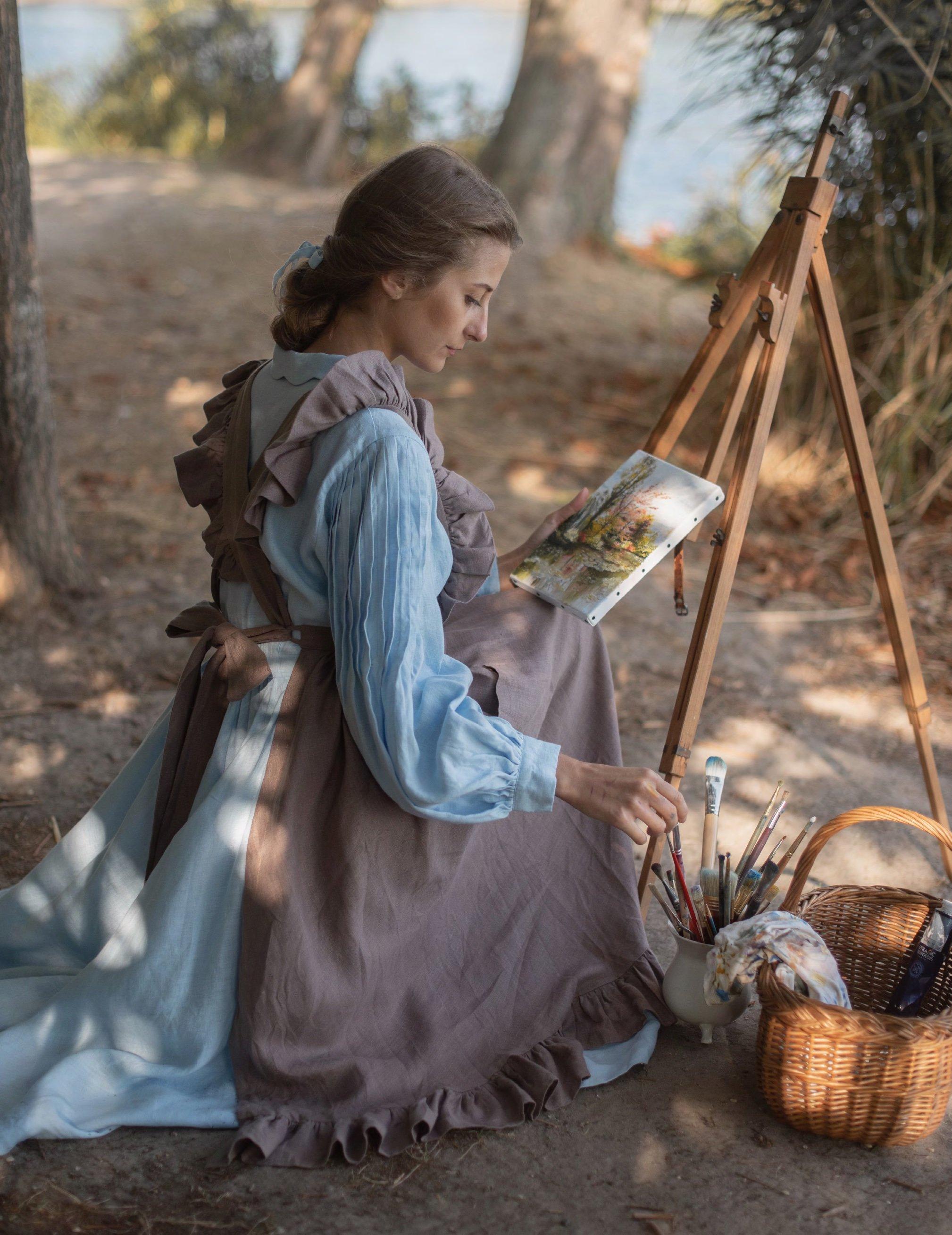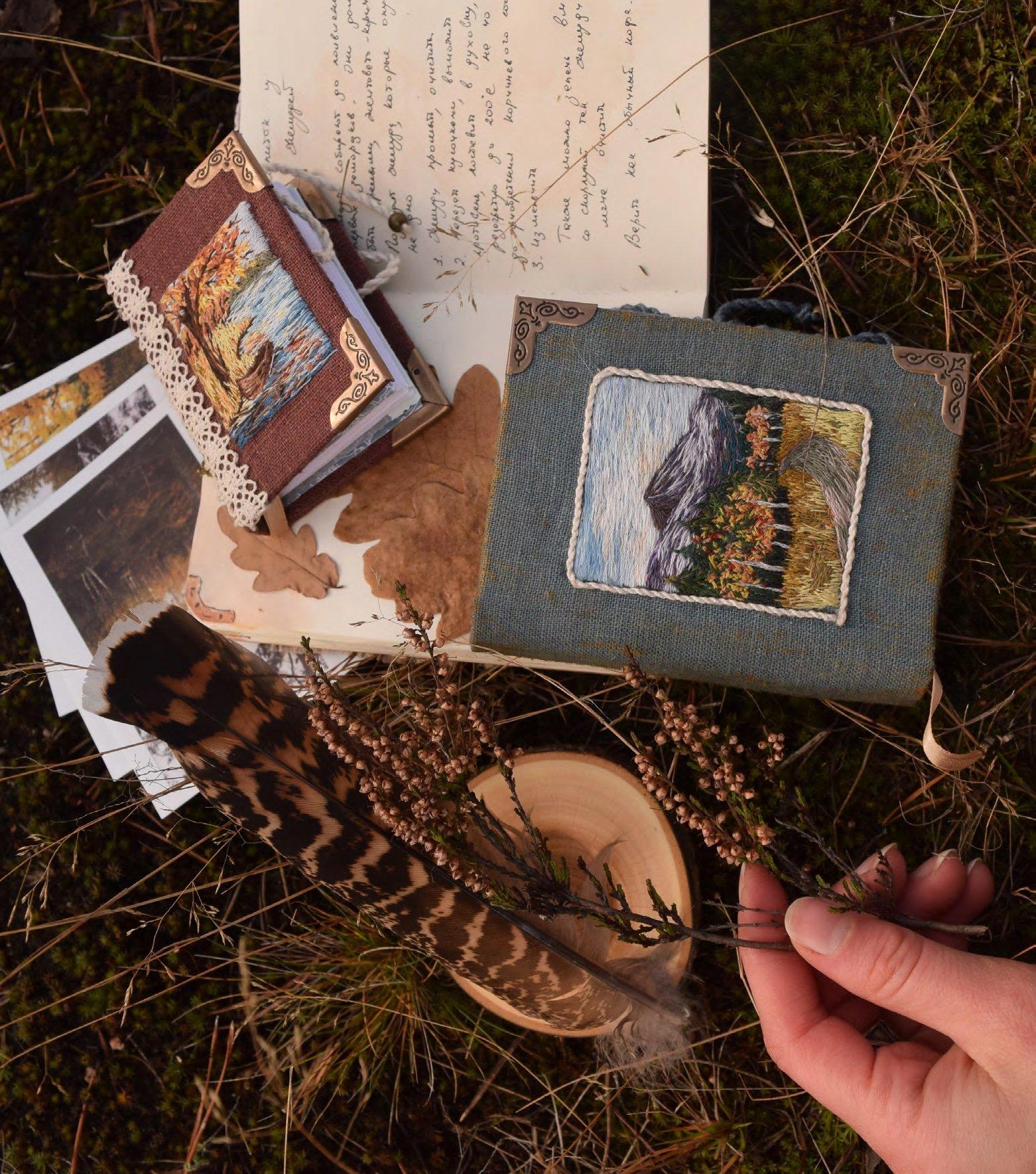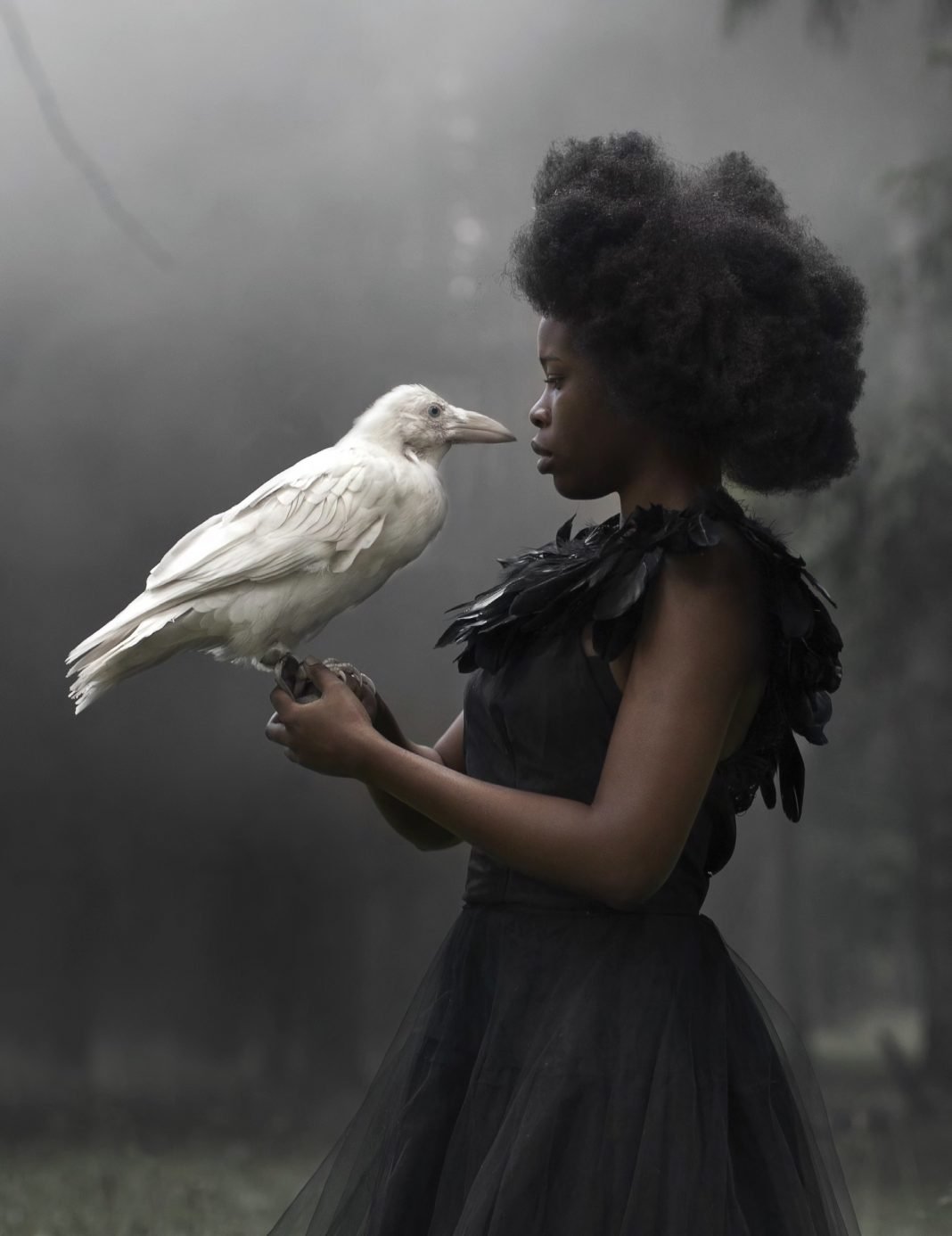Photography by KATERINA PLOTNIKOVA Model NORMILA
Who doesn’t want to be romantic? But I don’t mean romantic with a small r. I mean capital R Romantic, like the poet Percy Bysshe Shelley, who was discovered by one of his schoolmasters at Eton standing at the center of his dorm room, surrounded by the blue flames of a scientific experiment. Asked what he was doing, he is supposed to have answered, “Sir, I am attempting to summon the Devil.”
Irreverent and revolutionary, yet sentimental and deeply attuned to the splendor of ordinary things, particularly in the natural world, Romantic writers and artists broke with the conventions of the 18th century to introduce new ways of thinking and being. They were a wildly different bunch, from the iconoclast Shelley to the philosophical William Wordsworth, from the visionary William Blake to the antiquarian Sir Walter Scott, from the careful chronicler Dorothy Wordsworth to Mary Shelley, creator of nightmares. They certainly did not think of themselves as representing a single movement—they had disagreements and quarrels, and sometimes disliked each other intensely. Yet we can look back on what they wrote and said, how they lived, as aspects of a movement that changed the world.
Their influence lingered long after they were gone: We can see it in the later 19th century, in writers as different as Edgar Allen Poe, Emily Brontë, and Thomas Hardy. And we can see it in our own technological 21st century, with our renewed interest in and concern for the environment, our political activism, and even our internet fads. Cottagecore and the Mori girl may provide us with pretty images on Instagram, but they express a deeper desire for connection with the past and with a rural landscape that seems increasingly under threat. I think there is something important and authentic about this desire. Our century allows us to do so much that the Romantics could only have dreamed about—after all, science fiction grew out of the Romantic movement, and I suspect that Samuel Taylor Coleridge would have been fascinated by a cell phone. Yet we have a keen sense that we are losing some of the things that were important to them.
I suggest that we become modern Romantics and incorporate certain aspects of the Romantic movement into our own lives. How do we do that? Read on …
SPEND TIME IN NATURE
Romanticism was in rebellion against the movement that had come before it: Classicism, which looked back at the seeming order, rationality, and ideal proportions of the Greek and Roman world. We know now that the classical world wasn’t really all that rational and orderly. Greek statues were gaudily painted, and while Aristotle was copying down the dialogues of Socrates, female worshippers of Demeter performed the mysterious Eleusinian rites. Eighteenth century Classicism could be as stiff and conventional as a couplet by Alexander Pope, who wrote, “Know then thyself, presume not God to scan; / The proper study of mankind is man.” The Romantics wanted to scan a lot more than that! They wanted to experience divinity, and poets like Wordsworth found it in nature. In
“Lines Composed a Few Miles above Tintern Abbey,” he wrote:
… Nature never did betray
The heart that loved her; ‘tis her privilege,
Through all the years of this our life, to lead
From joy to joy: for she can so inform
The mind that is within us, so impress
With quietness and beauty, and so feed
With lofty thoughts, that neither evil tongues,
Rash judgments, nor the sneers of selfish men,
Nor greetings where no kindness is, nor all
The dreary intercourse of daily life,
Shall e’er prevail against us …
If you’re tired of the “dreary intercourse of daily life” (and who isn’t sometimes?), get yourself to nature. Go into the forest, or even to a local park. Walk under the trees. Listen to the birds, the wind in the leaves, the sound of water if there is any nearby. Look down at the grass. Can you see clover or creeping Charlie? Forget your cell phone—you can take photos another time. Experience the natural world the way Wordsworth might have when he wrote that poem about daffodils.
Or if you need inspiration, read some of the modern writers who pay close attention to the natural world. The poems of Mary Oliver will teach you to look at it more closely and to feel the spirit that Wordsworth found there. Anne Morrow Lindbergh’s Gift From the Sea and Tove Jansson’s The Summer Book will transport you to outdoor spaces and wash your soul like a cleansing rainstorm.
VALUE THE SIMPLE AND CHILDLIKE
Blake wrote Songs of Innocence from the perspective of a child, which he considered more pure and wise than the experience of an adult. It was the child who could see injustices that adults accepted and feel joys that adults might dismiss as unsophisticated. If you think about the children you know, you’ll realize that they aren’t all sweetness and light. Certainly not when they’re drawing on the walls with crayons, or trying to eat dog food, or asking you to read Goodnight Moon for the hundredth time! But the world is so new to them that everything in it is wonderful. A child can spend an hour staring at an inchworm making its way up a leaf, or assemble a collection of discarded rusty screws. There is something magical in that capacity for delight.
Once in a while, try to see the world with the eyes of a child. Value simple, ordinary things: sunlight falling across the floor, the fur of a cat under your hand, a cup of tea. Read a book you love over and over again. Sing without worrying about whether you’re in tune. Paint without caring whether you’re any good. After all, Picasso once said that it took him a lifetime to paint like a child. Maybe it will take you less time than Picasso! Display those paintings proudly, as if they were gifts from your favorite little brother or sister.

GET A LITTLE DARK AND GOTHIC
The Romantic movement included the Gothic Revival, when Horace Walpole built his ornate villa Strawberry Hill and popular literature featured the horrid shockers Jane Austen affectionately mocked in Northanger Abbey. If you want to go back to that original Gothic inspiration, you might try the novels of Ann Radcliffe, whom Austen herself admired even as she pursued a more realistic style of writing. If it’s autumn and the sky outside is gray with a hint of rain, make yourself a mug of hot chocolate, wrap yourself in a warm blanket, and read The Mysteries of Udolpho. You will be swept out of the ordinary world to the forested mountains of Italy, with their brigands and haunted castles.
If you need a little Gothic in your own life, model yourself on Ligeia or Morticia Addams. Browse a bookstore filled with ancient tomes (that no doubt contain forbidden wisdom—or at least have that lovely old book smell), host a picnic in a cemetery, or just paint your nails black, dark purple, silver. Let yourself feel a little dark and witchy. Buy Halloween decorations in August. Be inspired by Alice Hoffman’s Practical Magic or the designs of Christine McConnell.
RETURN TO THE PAST FOR A WHILE
The Romantics were fascinated by the past—not the classical past of Greece and Rome but the local history of England, Ireland, and the Scottish Highlands. Sir Walter Scott popularized the historical romance with novels like Waverly and Ivanhoe. His progeny include contemporary works such as Hilary Mantel’s Wolf Hall, Diana Gabaldon’s Outlander series, or the more fantastical Jonathan Strange and Mr. Norrell by Susanna Clarke. You could read a historical novel, but you could also research the history of where you live. Whether it’s a big city or a small town only its inhabitants have heard of, it has a history worth exploring.
Alternatively, research the history of your family. You will certainly find things both beautiful and heartbreaking, because life is more like a Gothic novel than we like to think. Save family photographs in a hatbox, value your grandparents’ silver and china, or buy old postcards in an antiques store and imagine who sent them. Collect old gloves and fans. When the present feels overwhelming, it’s reassuring to go back to the past for a while. It teaches us that human lives are never perfect, but certain things, like love and memory, endure.
TRY TO IMPROVE THE WORLD
Not all the Romantics were revolutionaries, but they tended to be idealistic and political. Mary Shelley’s monster challenges Frankenstein, who does not care for his creation—as the lower classes of England were beginning to challenge a conservative government, sparking fears that the French Revolution might be followed by one on English soil. There was a lot to agitate against in the early 19th century, including the oppression of women and the brutality of the slave trade. Percy Shelley warned the aristocratic classes what awaited them in his poem “Ozymandias,” where the statue of the King of Kings lies fallen and forgotten, surrounded by barren sand.
Unlike Lord Byron, who died supporting the Greek war of independence from the Ottoman Empire, you don’t have to join a revolution to help your fellow human beings. But think about what you can do, from helping in a soup kitchen to getting out the vote. Pick up trash in a nature preserve, contribute to a charity, march for justice. Practice kindness and seeing other people as valuable in themselves.
NURTURE YOUR CREATIVE SIDE
Write a poem. Crochet an afghan. Bake a cake. Coleridge had his own complicated definition of imagination, argued over by English professors, but in general the Romantics believed in the creative power of the mind. So be creative, whether it’s in painting a watercolor landscape, sewing a dress, or writing the great American novel.
Nurture your creativity by going to a museum. Spend the afternoon looking at art—perhaps, like the melancholy, tubercular John Keats, you’ll be inspired by a Grecian urn. Listen to music. (Keats was carried away by the song of a nightingale, but you can choose anything, from folk ballads to Florence and the Machine.) If you can’t travel to the Alps or Lake Geneva, drive to your local nature preserve. Keep a scrapbook of things that inspire you. Read voraciously, whether historical fiction, graphic novels, murder mysteries, or gardening books. Think of creativity as an appetite—feed it on beauty and wisdom, or just random strange things you happen to find. And in whatever medium: create, create, create.

LEARN TO FOLLOW YOUR HEART
For all their interest in the latest scientific theories, the Romantics believed in emotion and sentiment. Their biographies are filled with love, friendship, rivalry—enough drama for an entire Netflix season. They were individualists, believing in their unique visions, creating their own paths rather than following ones that had been laid down by society. This could, of course, get them into trouble. Although Coleridge’s poem “Kubla Khan” was inspired by an opium dream, his addiction to the drug ruined his health and finances. The Romantics tended to romanticize mental illness and instability as part of poetic creation. Keats’s knight-at-arms in “La Belle Dame Sans Merci” wakes up on a cold hillside that could be a metaphor for depression.
But their emphasis on beauty, feeling, and intuition also created great art. Keats’s “Bright Star,” written to Fanny Brawne, is one of the most beautiful love poems ever written. So give yourself permission to be emotional, to follow your intuition and figure out who you are as opposed to who society wants you to be. Cry while watching old black-and-white films like Casablanca, or the movie Bright Star, which tells Keats’s story from Fanny’s perspective. Write letters of gratitude to people who have helped you, or of enmity to those who have hurt you (but burn those without sending them). Don’t be ashamed to love what you love, whether it’s an old sweater, or vanilla ice cream, or inspirational quotations—write them on cards and pin them to a corkboard. Start keeping a journal. So what if your life seems ordinary? If you look closely enough at anything, you’ll find that it isn’t ordinary at all. For inspiration, read the Grasmere Journals of Dorothy Wordsworth or May Sarton’s The House by the Sea.
To be a Romantic was, in a sense, to be romantic. The writers and artists of that era were in love with the world, even when they were in rebellion against it. They could be a mess—you really don’t want Lord Byron at your house party. But they lived passionate, creative lives filled with appreciation for nature, beauty, and art, as well as the desire to make their world more free and equitable. Being a modern Romantic means bringing that idealism into our cynical era, which could use a medicinal dose of poetry—and vanilla ice cream.


































